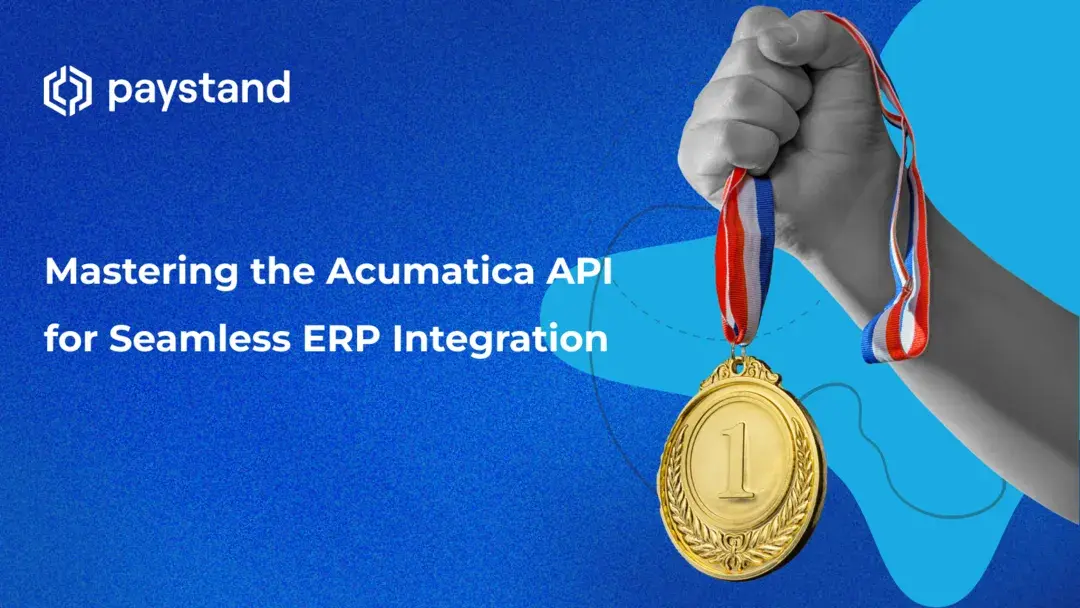Mastering the Acumatica API for Seamless ERP Integration

Table of Contents
- What programming language is Acumatica?
- Does Acumatica have an API?
- How to use the Acumatica API?
- Acumatica API + ERP integrations
- Paystand’s Acumatica integration: revolutionizing ERP payments
Key Takeaways
- Acumatica features a robust API that enables seamless integration with various applications and services, enhancing ERP processes
- The Acumatica API allows businesses to automate tasks, integrate third-party applications, and customize the software to align with specific operational needs
- Acumatica supports cross-platform development, enabling integration with various devices and environments
- The API enhances ERP payments by integrating payment gateways, automating processes, and ensuring secure financial transactions
- Businesses can leverage the Acumatica API for real-time data access, reporting, and scalable solutions
Acumatica’s accounting software is a powerful ERP solution with robust features to streamline business processes. One of its most valuable components is the Acumatica API, which allows seamless integration with various applications and services.
In this article, we’ll address common questions about the Acumatica API and explore how it can enhance ERP payments and other processes.
What Programming Language is Acumatica?
Acumatica uses the C# programming language, a powerful, object-oriented language widely used for developing enterprise-level applications. While C# is the backbone of Acumatica’s development, the API is designed to be accessible and usable by developers with experience in various programming languages. Here’s how this flexibility benefits developers:
- RESTful API standards: REST, an architectural style for networked applications. It uses standard HTTP methods and is language-agnostic, allowing interaction with the Acumatica API regardless of programming language.
- SON and XML data formats: The Acumatica API returns data in JSON or XML formats. JSON is preferred for modern applications as it's lightweight and easy to manipulate.
- Cross-platform development: Acumatica is accessible through RESTful web services, so developers can create cross-platform applications that integrate with It. This is valuable for businesses that need to access it from various devices and environments.
- Ease of learning: The RESTful API makes learning easy and accessible to many developers, benefiting businesses' talent search.
This flexibility means businesses looking to enhance the ERP payments process can integrate Acumatica with various payment gateways, accounting software, and financial services, ensuring smooth and efficient financial operations.
Does Acumatica Have an API?
Yes, Acumatica does have an API. It provides comprehensive tools to interact with the software programmatically, allowing businesses to automate tasks, integrate third-party applications, and enhance efficiency.
Since the Acumatica API is accessible across different programming languages, businesses can leverage it to build custom solutions that align with their operational needs.
Acumatica API’s Key Benefits
- Routine tasks automation: Automates routine tasks, minimizing human error and freeing up valuable time for more strategic activities.
- Third-party application integration: Seamlessly integrates with third-party applications like CRM, e-commerce platforms, and specialized industry software, creating a unified digital ecosystem.
- Enhanced ERP payments: Enhances ERP payments by integrating payment gateways, automating processing, and ensuring accurate financial transaction records.
- Customization and flexibility: Highly customizable, allowing developers to tailor its functionality to specific business requirements and align with operational goals.
- Real-time data access and reporting: Provides real-time data access from ERP systems, enabling accurate and timely reporting essential for informed decision-making. Supports data extraction in different formats for customized reports.
- Scalability: Scales effortlessly with your business growth, managing increased data and complex processes, ensuring sustained value as operations become more intricate.
- Enhanced security: Offers advanced security features to safeguard sensitive financial data, ensuring secure transmissions and full compliance with data protection standards.
What Type of API Does Acumatica Use?
Acumatica uses a RESTful API, known for its simplicity and ease of use, making it a preferred choice for developers. With the Acumatica REST API, you can perform various operations, such as querying data, creating records, and automating processes within Acumatica.
How to Use the Acumatica API?
Using the Acumatica API is straightforward for developers familiar with RESTful standards. Here’s a basic overview:
-
Authentication: Before making API calls, you must authenticate your application with the Acumatica server using an API key or OAuth.
-
API endpoints: Acumatica provides various endpoints corresponding to different software modules, such as Sales, Inventory, or ERP payments.
-
Making requests: To interact with the data within Acumatica, you can make GET, POST, PUT, or DELETE requests. For example, you can retrieve customer information or update payment records.
-
Handling Responses: The API will return data in JSON format, which you can then parse and use in your application.
For a more detailed guide on using the Acumatica API, check out the official documentation or explore integration solutions that can streamline the process.
Acumatica API + ERP Integrations
The Acumatica API is key for businesses looking to expand their ERP functionality through seamless integrations. Businesses often rely on multiple software to manage different operations; the Acumatica API facilitates these integrations, allowing them to create a unified platform that centralizes their operations and enhances overall efficiency.
Unifying Business Functions with Acumatica API Integrations
- Streamlining accounting processes: Integrating Acumatica with specialized accounting software automates key financial processes, reduces data entry, and ensures accuracy. This allows businesses to generate real-time reports, track expenses, and manage budgets more effectively.
- Enhancing CRM: Acumatica integration enhances customer relationship management by synchronizing information, tracking interactions, and managing sales pipelines. This integration provides up-to-date customer data, improving customer experience and driving sales growth.
- Optimizing supply chain management: Acumatica API integrations can improve supply chain management by connecting inventory, procurement, and logistics systems. This integration enables real-time inventory tracking, automated reordering, and efficient supplier management, reducing costs and enhancing supply chain efficiency.
- Seamless connectivity with payment processors: Acumatica API enables integration with payment processors, allowing businesses to automate payment processing, reconcile accounts swiftly, and minimize financial transaction errors.
Paystand’s Acumatica Integration: Revolutionizing ERP Payments
One of the standout integrations for Acumatica is Paystand’s. It leverages the power of the Acumatica API to bring zero-touch payments and blockchain-based payment verification directly into the ERP system. Here’s how this integration benefits businesses:
- Automating the payment process
- Enabling zero-touch payments
- Leveraging blockchain for payment verification
- Seamless integration with Acumatica
Visit our Acumatica integrations page to learn more and explore other powerful integrations.






